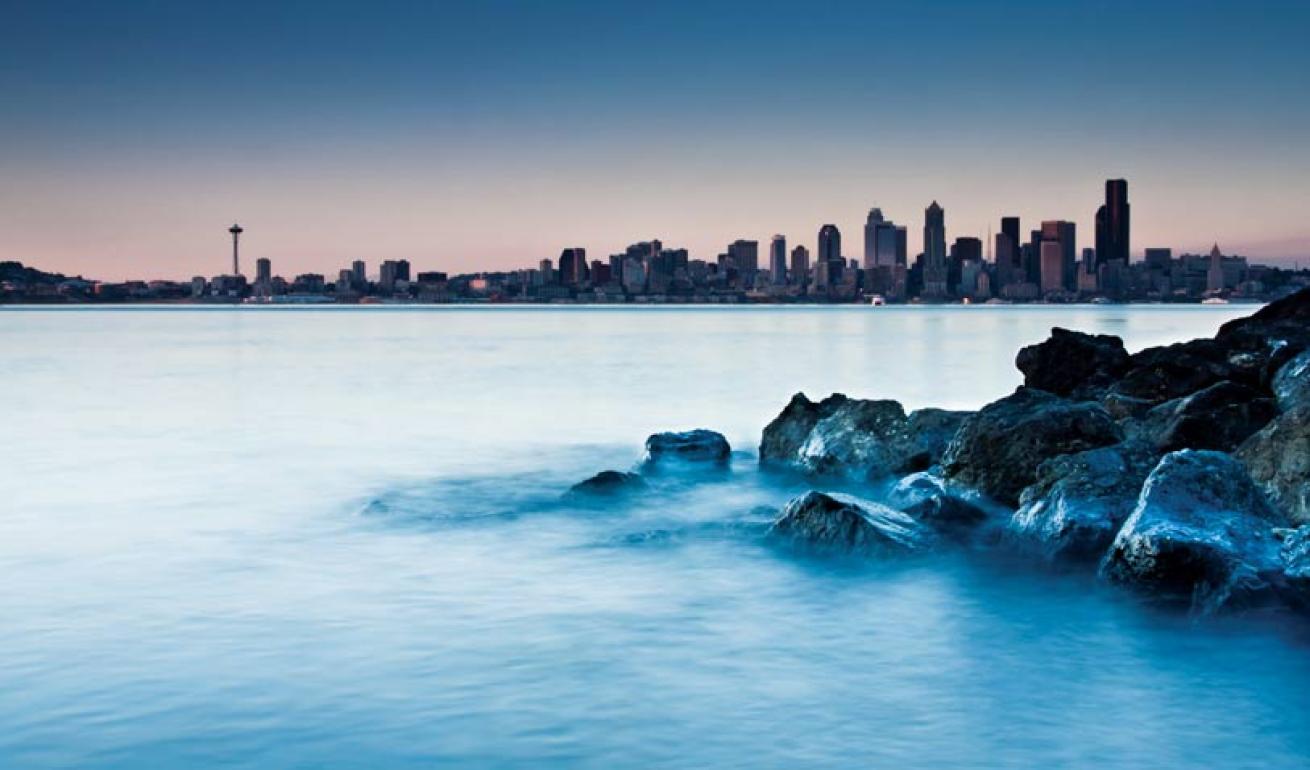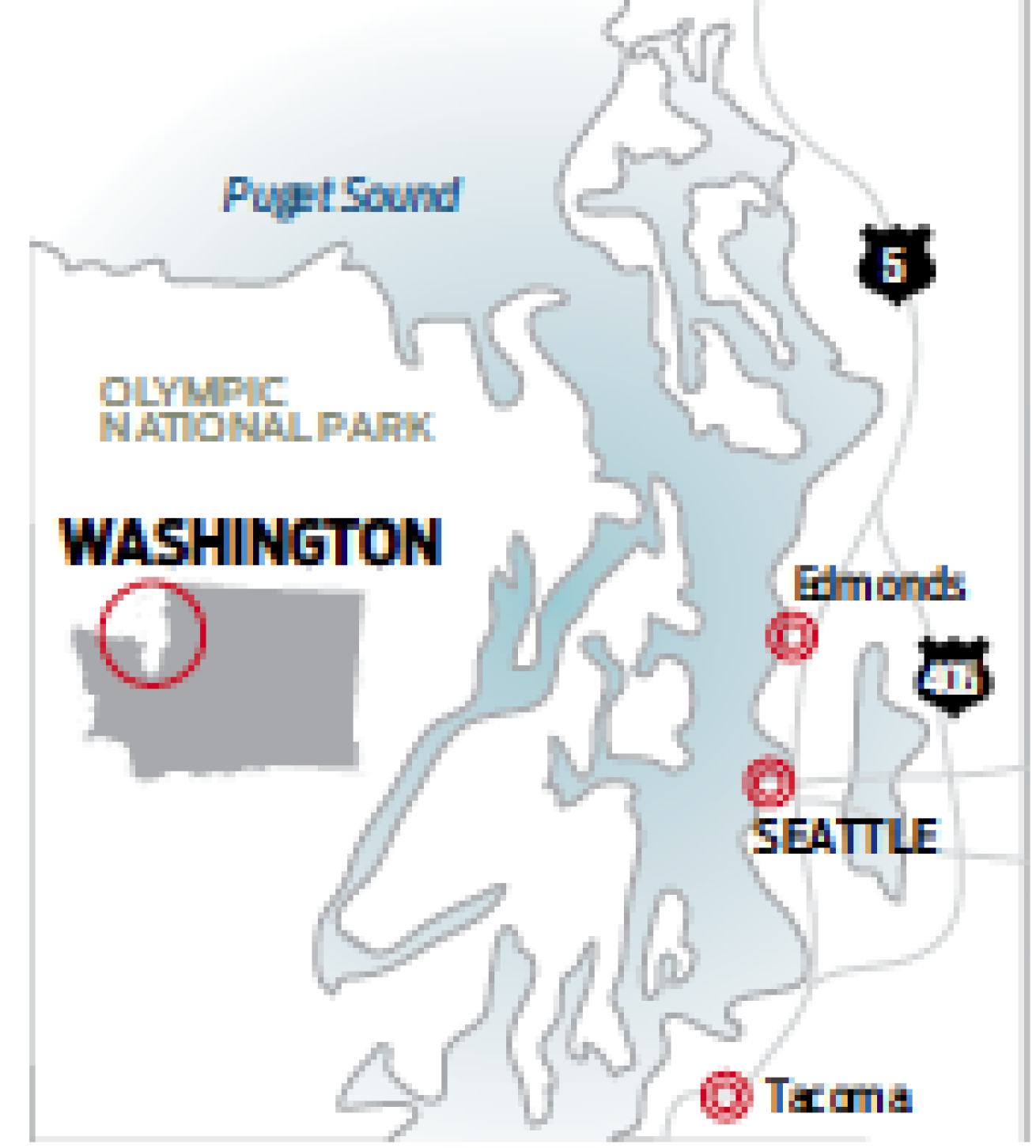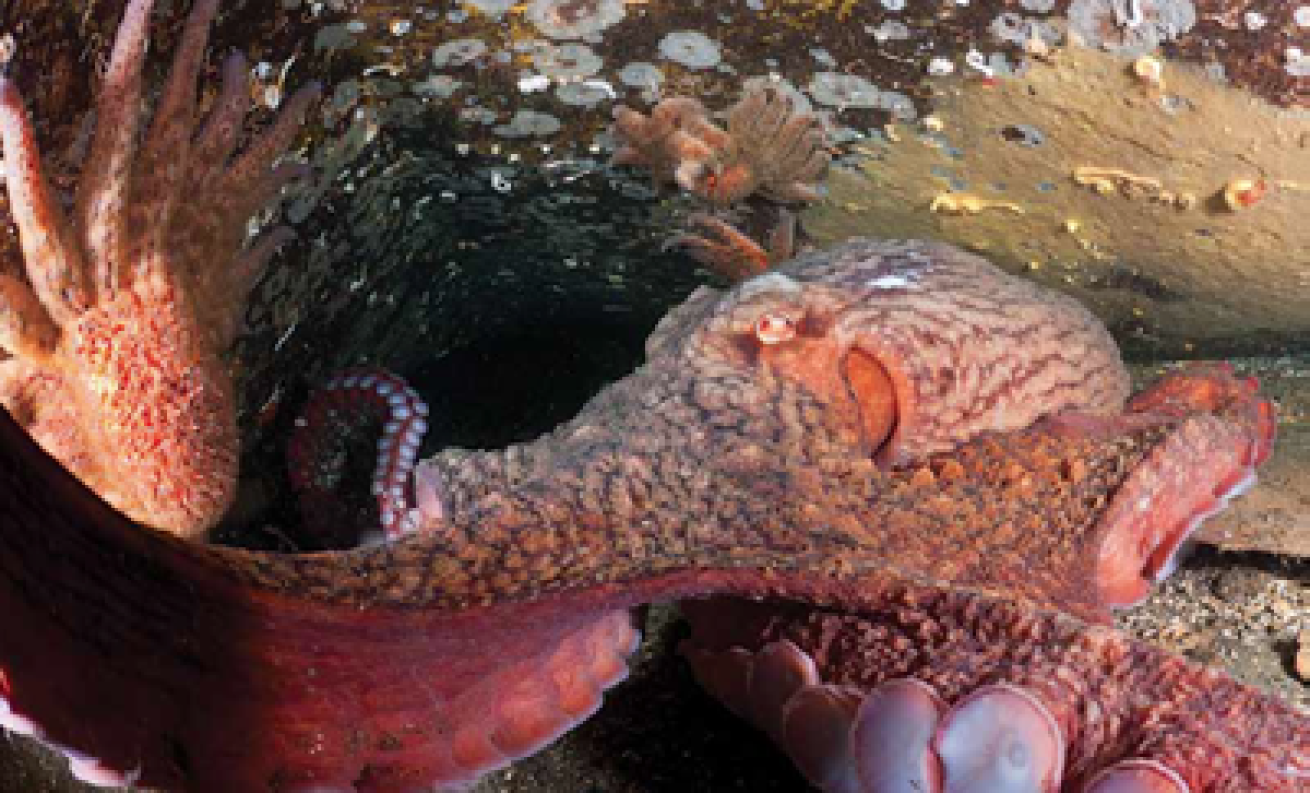Scuba Diving Seattle: Puget Sound

Seattle Puget Sound
With more than 75 shore-diving sites within an hour of Seattle, Puget Sound offers a menu of submerged attractions like few other places in the world. Underwater fjords, rocky reefs, wooden or steel wrecks, Steller sea lions, gardens of giant plumose anemones, killer whales and more. Whether you enjoy slow-moving macro photography or adrenaline-pumping drift diving, the Emerald Sea can satisfy every coldwater diver’s taste. Water temperatures hover around 50 degrees year-round, but with a modern drysuit, divers can easily clock 60 to 75 minutes of bottom time in reasonable comfort. In fall and winter, when the algae is dormant, visibility is at its best; yet during summer, with 16 hours of daylight, you can experience amazing 18-hour-long diving days. Because of the colder water, animals tend to move more slowly, perfect for photographers and videographers.

More than 13,000 years ago, receding mile-high glaciers carved out the land between the Cascade and Olympic mountains where the 100-mile-long Puget Sound and Hood Canal now exist. Surfacing after a dive in Edmonds Underwater Park, being greeted by the Olympic Mountains almost makes it OK that your dive is over.
Puget Sound has been explored and settled for more than 2,000 years by Native Americans. The coastal Tulalip, Swinomish, Lummi and Skagit tribes were considered rich because of the abundant natural food resource; salmon, crabs, shrimp, oysters, mussels, halibut and clams from this region now feed the world. They are not only found at Pike Place Market in downtown Seattle and all the restaurants, they are what divers experience on a daily basis. Few sights here are more exciting than watching a three-inch heart cockle (an animal that looks like a clam) extend its foot out of its shell and literally leap away from its enemy, the sunflower star — the fastest-moving sea star on the planet, with up to 24 arms and 15,000 tubed feet crawling three feet a minute.
Protected for more than four decades, Edmonds Underwater Park is one of the oldest marine parks in the United States. When you arrive at the parking lot, don’t be alarmed if you have to wait for a spot to unload your gear, as Edmonds is a favorite in the region. You’ll don your equipment in sight of the snow-covered Olympic Mountain Range. As you snorkel out to the buoys that mark the park, you’ll watch ferries run to and from Bainbridge Island.
Below the surface, Puget Sound comes alive. Hearty lingcod, which can grow up to five feet long, use camouflage to blend in with the colorful lettuce and red algae. Look closely to find shrimp, nudibranchs and a rainbow of encrusting corals and algae. Nesting cabezon, gardens of giant plumose anemones, and 80-year-old rockfish are other common sights in the Sound. And on just about every dive, you’ll witness crabs feeding, mating, fighting or molting.

Bizarre-looking ratfish can be found at most sites, hovering in water 30 feet or deeper. With both cartilage and bony skeletons, they are believed to be the link between fish and sharks. While diving the Coves at Seacrest, you might spot another rare prehistoric-looking animal: a sixgill shark. Sunrise Reef in Tacoma is another local favorite because two of the most sought-after creatures in the Sound, wolf eels and giant Pacific octopus, are plentiful here. GPOs have a 25-foot tentacle span and are the largest octopus in the world. Back in the 1960s, dive clubs used to hold World Champion Octopus Wrestling contests here. Teams of divers try to find the largest octopus, wrestle it out of its hole, bring it to shore to be weighed, and then release it back into the deep sea. Fortunately, divers now hunt these animals with cameras only.
From July through September, divers have a good chance of seeing lion’s mane jellies. With a reddish bell, these animals extend their tentacles up to 10 feet to hunt for crustaceans and small fish. They have no eyes, no ears and no brain, yet they are one of the greatest predators of the sea. Moon jellies and egg yolk jellies can be spotted here too.
Itinerary:
- Day 1: Grab tanks and weights from Underwater Sports Seattle and head to Alki Beach in West Seattle. Don’t miss the Honeybear, your first chance at spotting a GPO (local lingo for giant Pacific octopus). Macro lovers should exploring Alki Junkyard at slack tide. Between dives, go to Duke’s for award-winning chowder, blackened salmon and Dungeness crab.
- Day 2: Drive to the South Sound and pick up a boat from Bandito Charters at Dock Street. Sunrise Reef in Gig Harbor virtually guarantees wolf eel and octo sightings, and Dalco Wall boasts a 100-foot face. Lunch is included. Head back to Seattle for dinner at Local 360, where everything comes from within 360 miles of the restaurant.
- Day 3: After breakfast at Anthony’s in the marina, check the tides and plan on two dives exploring Edmonds Underwater Park. Arrange for a divemaster through Underwater Sports Edmonds or stop by the shop to get a map and orientation before heading out. Bruce Higgins and volunteer divers have set up lines with points of interest along the way. You will build up an appetite with a long surface swim at the beginning of the dive. Spend the afternoon exploring Seattle.
Need to Know:
- Dive Conditions: To be warm, you want a drysuit with thermal undergarments made for the Arctic. Water temps are a chilly 45 to 55 degrees F year-round.
- When to Go: Winter has the best viz, but summer months allow long diving days. Avoid spring’s algae blooms and glacier runoff.
- Operators: Underwater Sports, with six locations, is known as the leader in the Pacific Northwest (under watersports.com). Bandito Charters offers two- and three-tank boat dives out of Tacoma for $75 to $100 (banditocharters.com).
- Best Tip: Plan your trip around the tides, looking for minimal tidal exchange to maximize flexibility. On full and half moons, some of the sites are not accessible because tidal flow can be 16 to 20 feet.
- Must Sees: Historic Pike Place Market is full of seafood, flowers and local artists. Get a cup of coffee from the very first Starbucks. The Underground Tour of Seattle is a best-kept secret. Head over to the Seattle Center to experience the trifecta: the Space Needle, EMP Museum, and the Chihuly Garden and Glass Museum. If you miss any must-see critters while diving, visit the Seattle Aquarium.

SCDPuget Sound
With more than 75 shore-diving sites within an hour of Seattle, Puget Sound offers a menu of submerged attractions like few other places in the world. Underwater fjords, rocky reefs, wooden or steel wrecks, Steller sea lions, gardens of giant plumose anemones, killer whales and more. Whether you enjoy slow-moving macro photography or adrenaline-pumping drift diving, the Emerald Sea can satisfy every coldwater diver’s taste. Water temperatures hover around 50 degrees year-round, but with a modern drysuit, divers can easily clock 60 to 75 minutes of bottom time in reasonable comfort. In fall and winter, when the algae is dormant, visibility is at its best; yet during summer, with 16 hours of daylight, you can experience amazing 18-hour-long diving days. Because of the colder water, animals tend to move more slowly, perfect for photographers and videographers.

SCDPuget Sound Map
More than 13,000 years ago, receding mile-high glaciers carved out the land between the Cascade and Olympic mountains where the 100-mile-long Puget Sound and Hood Canal now exist. Surfacing after a dive in Edmonds Underwater Park, being greeted by the Olympic Mountains almost makes it OK that your dive is over.
Puget Sound has been explored and settled for more than 2,000 years by Native Americans. The coastal Tulalip, Swinomish, Lummi and Skagit tribes were considered rich because of the abundant natural food resource; salmon, crabs, shrimp, oysters, mussels, halibut and clams from this region now feed the world. They are not only found at Pike Place Market in downtown Seattle and all the restaurants, they are what divers experience on a daily basis. Few sights here are more exciting than watching a three-inch heart cockle (an animal that looks like a clam) extend its foot out of its shell and literally leap away from its enemy, the sunflower star — the fastest-moving sea star on the planet, with up to 24 arms and 15,000 tubed feet crawling three feet a minute.
Protected for more than four decades, Edmonds Underwater Park is one of the oldest marine parks in the United States. When you arrive at the parking lot, don’t be alarmed if you have to wait for a spot to unload your gear, as Edmonds is a favorite in the region. You’ll don your equipment in sight of the snow-covered Olympic Mountain Range. As you snorkel out to the buoys that mark the park, you’ll watch ferries run to and from Bainbridge Island.
Below the surface, Puget Sound comes alive. Hearty lingcod, which can grow up to five feet long, use camouflage to blend in with the colorful lettuce and red algae. Look closely to find shrimp, nudibranchs and a rainbow of encrusting corals and algae. Nesting cabezon, gardens of giant plumose anemones, and 80-year-old rockfish are other common sights in the Sound. And on just about every dive, you’ll witness crabs feeding, mating, fighting or molting.

SCDDiving Image
Bizarre-looking ratfish can be found at most sites, hovering in water 30 feet or deeper. With both cartilage and bony skeletons, they are believed to be the link between fish and sharks. While diving the Coves at Seacrest, you might spot another rare prehistoric-looking animal: a sixgill shark. Sunrise Reef in Tacoma is another local favorite because two of the most sought-after creatures in the Sound, wolf eels and giant Pacific octopus, are plentiful here. GPOs have a 25-foot tentacle span and are the largest octopus in the world. Back in the 1960s, dive clubs used to hold World Champion Octopus Wrestling contests here. Teams of divers try to find the largest octopus, wrestle it out of its hole, bring it to shore to be weighed, and then release it back into the deep sea. Fortunately, divers now hunt these animals with cameras only.
From July through September, divers have a good chance of seeing lion’s mane jellies. With a reddish bell, these animals extend their tentacles up to 10 feet to hunt for crustaceans and small fish. They have no eyes, no ears and no brain, yet they are one of the greatest predators of the sea. Moon jellies and egg yolk jellies can be spotted here too.
Itinerary:
- Day 1: Grab tanks and weights from Underwater Sports Seattle and head to Alki Beach in West Seattle. Don’t miss the Honeybear, your first chance at spotting a GPO (local lingo for giant Pacific octopus). Macro lovers should exploring Alki Junkyard at slack tide. Between dives, go to Duke’s for award-winning chowder, blackened salmon and Dungeness crab.
- Day 2: Drive to the South Sound and pick up a boat from Bandito Charters at Dock Street. Sunrise Reef in Gig Harbor virtually guarantees wolf eel and octo sightings, and Dalco Wall boasts a 100-foot face. Lunch is included. Head back to Seattle for dinner at Local 360, where everything comes from within 360 miles of the restaurant.
- Day 3: After breakfast at Anthony’s in the marina, check the tides and plan on two dives exploring Edmonds Underwater Park. Arrange for a divemaster through Underwater Sports Edmonds or stop by the shop to get a map and orientation before heading out. Bruce Higgins and volunteer divers have set up lines with points of interest along the way. You will build up an appetite with a long surface swim at the beginning of the dive. Spend the afternoon exploring Seattle.
Need to Know:
- Dive Conditions: To be warm, you want a drysuit with thermal undergarments made for the Arctic. Water temps are a chilly 45 to 55 degrees F year-round.
- When to Go: Winter has the best viz, but summer months allow long diving days. Avoid spring’s algae blooms and glacier runoff.
- Operators: Underwater Sports, with six locations, is known as the leader in the Pacific Northwest (under watersports.com). Bandito Charters offers two- and three-tank boat dives out of Tacoma for $75 to $100 (banditocharters.com).
- Best Tip: Plan your trip around the tides, looking for minimal tidal exchange to maximize flexibility. On full and half moons, some of the sites are not accessible because tidal flow can be 16 to 20 feet.
- Must Sees: Historic Pike Place Market is full of seafood, flowers and local artists. Get a cup of coffee from the very first Starbucks. The Underground Tour of Seattle is a best-kept secret. Head over to the Seattle Center to experience the trifecta: the Space Needle, EMP Museum, and the Chihuly Garden and Glass Museum. If you miss any must-see critters while diving, visit the Seattle Aquarium.










